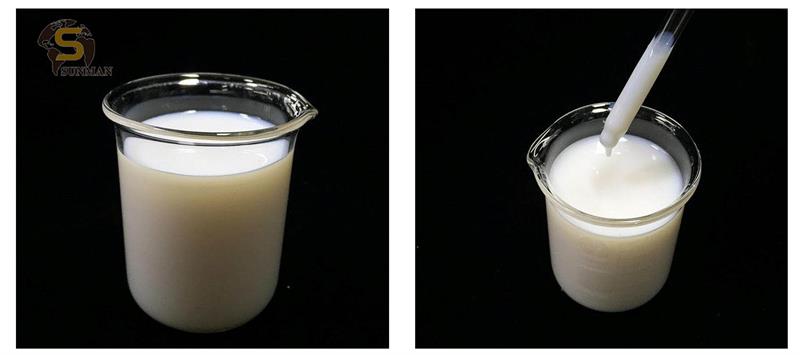Nhũ tương là hỗn hợp của hai hoặc nhiều nguyên liệu lỏng không hòa tan vào nhau (không thể trộn lẫn).
Hai loại nhũ tương chính là nhũ tương gốc nước và nhũ tương gốc dung môi.
Nhũ tương gốc nước là nhũ tương trong đó nước là pha liên tục hoặc chất mang chính.
Các hạt chất lỏng hoặc chất phụ gia khác, chẳng hạn như dầu, sau đó sẽ lơ lửng trong nước.
Sơn gốc nước là một trong những ví dụ phổ biến nhất của loại nhũ tương này.
Những hỗn hợp hóa chất đặc biệt này cũng được sử dụng trong ngành dệt may và hóa chất, công thức mực in và trong chất trám, chất kết dính và chất kết dính.
Các nhà sản xuất trong hầu hết mọi ngành công nghiệp đều sử dụng nhũ tương.
Những nhũ tương này ngày càng phổ biến vì chúng có lợi cho sức khỏe và môi trường.
Blog này sẽ khám phá các ứng dụng và lợi thế chính của chúng cũng như cách các nhà sản xuất công nghiệp có thể sử dụng chúng.
Sơn, Chất trám và Lớp phủ
Nhiều loại sơn công nghiệp, chất trám, vecni, sơn lót và lớp phủ bảo vệ hiện nay đều là loại gốc nước.
Những vật liệu này có thể được thêm vào bề mặt để tạo ra hoặc tăng cường các đặc tính mong muốn.
Hai ví dụ phổ biến là
nhựa acrylic gốc nước
và acrylic styrene gốc nước, một loại nhũ tương kết hợp các monome styrene và acrylic với nước.
Sử dụng sơn hoặc lớp phủ gốc nước như nhựa acrylic hoặc nhựa acrylic styrene có thể tăng cường độ bền, khả năng chống thấm nước, chống ăn mòn và mài mòn của bề mặt.
Nhựa acrylic và nhựa acrylic styrene cũng được tìm thấy trong các vật liệu đồ họa như sơn vẽ và sơn nội thất và ngoại thất.
Giấy và Mực in
Nhũ tương gốc nước có thể được sử dụng trong ngành công nghiệp giấy và in ấn để tạo ra các sản phẩm như mực in và lớp phủ bóng cho giấy.
Những lựa chọn này đảm bảo độ bám dính và khả năng chống nước tốt hơn đồng thời cho phép in thân thiện với môi trường.
Chất kết dính và chất kết dính
Chất kết dính và keo dán gốc nước, phổ biến trong đóng gói, chế biến gỗ và xây dựng, có đặc tính kết dính mạnh mẽ cho nhiều loại vật liệu khác nhau với tác động tối thiểu đến môi trường.
Ví dụ, người ta thêm vinyl acetate vào nước để tạo ra polyvinyl acetate (PVA), một loại keo dán thông dụng còn được gọi là keo trắng, keo dán gỗ hoặc keo dán thợ mộc.
Các nhà sản xuất trong nhiều ngành công nghiệp, từ xây dựng đến dệt may, đều sử dụng vật liệu đa năng này.
Sự thi công
Các nhà sản xuất và nhà thầu trong ngành xây dựng sử dụng nhiều sản phẩm gốc nước khác nhau.
Ví dụ, styren butadien (thường được gọi là cao su SBR hoặc mủ SBR) là một loại cao su kết dính linh hoạt được làm từ monome styren và butadien lơ lửng trong nước.
Nó được sử dụng cho nhiều mục đích khác nhau, bao gồm làm lớp lót thảm, để cải thiện nhựa đường và làm chất phụ gia cho bê tông nhằm cải thiện các đặc tính của bê tông, cùng nhiều công dụng khác.
Nhũ tương gốc nước thải ra ít hợp chất hữu cơ dễ bay hơi (VOC) hơn đáng kể so với các sản phẩm gốc dung môi.
VOC có trong hầu hết các sản phẩm gia dụng và được giải phóng vào không khí khi bạn sử dụng sản phẩm.
Việc không có VOC giúp cải thiện chất lượng không khí trong nhà và giảm ô nhiễm môi trường.
Chúng ít có khả năng gây ô nhiễm nguồn nước và việc làm sạch chúng chỉ cần xà phòng và nước thay vì dung môi nguy hiểm.
